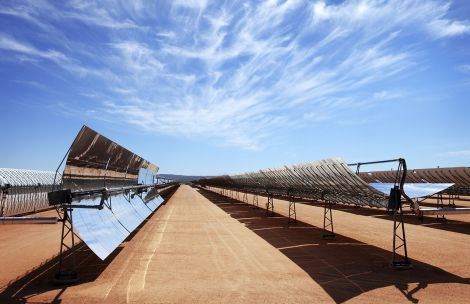Self-Cleaning Solar Panel Coating Optimizes Energy Collection, Reduces Costs
The accumulation of dust and sand on solar power reflectors and photovoltaic cells – also known as soiling ‑ is one of the main efficiency drags for solar power facilities, often reducing reflectivity up to 50 percent in 14 days.

The accumulation of dust and sand on solar power reflectors and photovoltaic cells – also known as soiling ‑ is one of the main efficiency drags for solar power facilities, often reducing reflectivity up to 50 percent in 14 days.
Under the sponsorship of the Department of Energy’s Energy Efficiency and Renewable Energy SunShot Concentrating Solar Power Program, Oak Ridge National Laboratory is developing a low-cost, transparent, anti-soiling (or self-cleaning) coating for solar reflectors to optimize energy efficiency while lowering operation and maintenance costs and avoiding negative environmental impacts.
The coating—which is being designed by members of the Energy and Transportation Science Division, including Scott Hunter, Bart Smith, George Polyzos, and Daniel Schaeffer—is based on a superhydrophobic coating technology developed at ORNL that has been shown to effectively repel water, viscous liquids, and most solid particles.
Unlike other superhydrophobic approaches that employ high-cost vacuum deposition and chemical etching to nano-engineer desired surfaces, ORNL’s coatings are deposited by conventional painting and spraying methods using a mixture of organics and particles. In addition to being low-cost, these methods can be deployed easily in the field during repairs and retro-fitting.
The coating must be very superhydrophobic to minimize the need for occasional cleaning, and it must have minimal (or even zero) effect on the transmission and scattering of solar radiation between the wavelengths of 250 to 3,000 nm.
To meet these requirements, the coating must be no more than a few hundred nanometers thick, and the embedded particles must be considerably smaller. The extremely thin coating must also be durable under environmental exposure, including UV radiation and sand erosion, and be compliant according to the U.S. EPA Agency Clean Air Act emission standards.
The anti-soiling coating exhibited excellent superhydrophobic properties, losing less than 0.3 percent of transparency over the entire solar radiation wavelength range. When exposed to several hundred hours of accelerated UV radiation and 100 hours of salt fog exposure, the coating exhibited no degradation in superhydrophobic or optical transmission properties.
In addition to anti-soiling coating for solar applications, ORNL researchers are using their superhydrophobicity expertise to develop anti-soiling cool roof coatings, as well as anti-icing and anti-condensation coatings for air conditioning and evaporative cooling applications, respectively.
Going into 2014, the project has been funded for another year and will optimize the coating and perform accelerated exposure tests, as well as begin development on a scalable coating technique and perform small-scale field testing.
Information for this story provided by Katie Elyce Jones from the Oak Ridge National Laboratory.
Related Content
-
Powder Coater Leverages Its Manufacturing Mindset for Success
As a former motorcycle manufacturer, this powder coating Top Shop benefits from understanding the finishing industry from a customer’s perspective.
-
Masking Solutions for Diverse Applications
Global Mask of Barcelona, Spain showcases its solutions at Paint Expo 2024 in Germany.
-
Can You Afford to Not Use Custom Masking?
Are you weighing the costs of a custom masking solution vs. an off-the-shelf solution? Christy Schulthess of Custom Fabricating & Supplies discusses the overall savings that can be realized with custom masking.








.jpg;maxWidth=300;quality=90)






